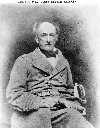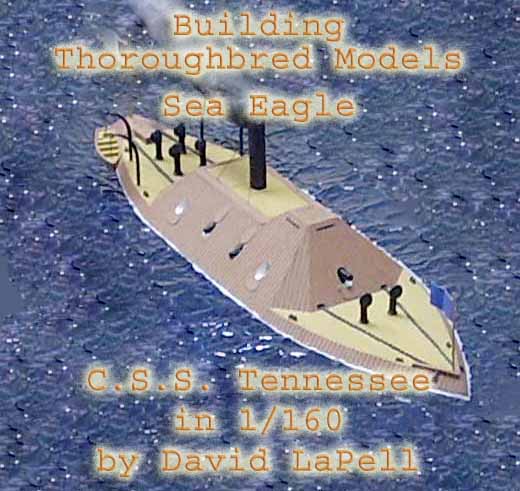| The ironclads constructed during the
American Civil War marked a turning point in history. In only four yeas,
sails and wood were replaced with gun turrets and iron plating.
One of the most significant ironclads to be built during the Civil
War was the C.S.S. Tennessee. Launched on February 28, 1863 at Selma, Alabama,
the Tennessee displaced 1,273 tons and was 209 feet long. Armed with six
muzzle loading guns (four 6.4 inch and two 7 inch Brooke rifles) that could
be pivoted out of the ironclad’s ten gun ports. The Tennessee also mounted
a ram at the bow and was protected by four inches of armor plate on the
sides and stern of the casemate and six inches of armor forward.
For all of the ship’s strengths however, the Tennessee had some
serious shortcomings. The most severe being the exposed chains that controlled
the rudder, running along the deck at the stern. The iron shutters that
covered the gun ports as the cannon were reloaded could also be jammed
by enemy shellfire. The Tennessee also suffered from unreliable engines,
which came from a Mississippi riverboat that was originally set up for
a paddlewheel, not the screw propellers that the ironclad used. All of
this left the Tennessee with a top speed of only six knots. |
| Despite all of the Tennessee’s flaws, when she was commissioned
on February 16, 1864 the large ironclad was still a force to be reckoned
with. The Confederacy put the ship in the capable hands of Admiral Franklin
Buchanan. Buchanan was the captain of the Confederate ironclad Virginia
(formerly the Merrimac) during its famous duel with the USS Monitor. Buchanan
was put in command of the Confederate naval forces guarding Mobile Bay,
Alabama, and he made the Tennessee his flagship. |
 |
On August 5, 1864 the Union fleet under the command of Admiral
David Glasgow Farragut entered Mobile Bay and engaged the guns of Fort
Morgan at Mobile Point. The Union fleet was a mixed bag of monitors, steam
sloops, steamers, and gunboats.
The Union ships were arranged in two columns, with the large
ships in one column each lashed to a gunboat on their starboard side. The
monitors were left free to lead the line, with the Tecumseh at the head
with its powerful 15-inch guns. |
 |
| At 0630, the Tecumseh opened fire on Fort Wagner,
with the rest of the Union fleet steaming directly behind. The Tecumseh
then turned to starboard to engage the Tennessee which was slowly lumbering
towards the Union ships. Between the Tennessee and the Tecumseh was a field
of Confederate “torpedoes” or mines as they are now known. As the Tecumseh
closed on the Tennessee, she struck a torpedo and heeled over onto her
port side. Within thirty seconds the monitor was gone along with 93 of
her crew.
The Tennessee then made for the line of wooden ships, followed
by the Confederate gunboats Selma, Gaines, and Morgan. It was at this time
that Farragut, on board the sloop Hartford, made his famous “Damn the torpedoes!”
command. The Brooklyn was steaming ahead of the Hartford when one of the
crew on board the former spotted the mines in the water ahead of the fleet.
The captain of the Brooklyn then put his engines full astern trying to
dodge the “torpedoes”. Farragut then had the Hartford pass the Brooklyn
to port. As the Hartford steamed past, the Brooklyn’s captain told Farragut
of the mine field in front of him. Farragut then gave his reply of “Damn
the torpedoes, full steam ahead!”
|
| The Tennessee then tried to ram the Hartford, but the six knot
speed was not enough, and instead Buchanan engaged the large ships as he
passed them by. The Tennessee received a glancing blow from the Monongahela
and then opened fire on the gunboat Kennebec with a broadside. The Tennessee
proceeded to trade broadsides with the rest of the ships in the line. The
Oneida, already having already lost a boiler to a shot from the Morgan,
had most of her lower rigging blasted away by the Tennessee as the ironclad
passed by. Buchanan then retired under the guns of Fort Morgan. |

|
Meanwhile the Selma, Gaines, and Morgan slugged it out with the
Union fleet. The Hartford and the steamer Metacomet were both hit hard,
but the guns of the Union ships took their toll. The Gaines, with her hull
severely holed, attempted to reach the protection of Fort Morgan, but sank
on route. The Selma surrendered and the Morgan managed to reach Fort Morgan,
fleeing to Mobile later in the evening.
Buchanan then decided to make another run at the Union fleet.
Farragut ordered his monitors and larger ships to engage the Tennessee.
The Monongahela and Lackawanna both rammed the ironclad, but received more
damage then they caused. Then the Hartford rammed the Tennessee, again
with little result. Then the monitor Manhattan opened fire on the Tennessee’s
port side with its 15 inch guns. One shot penetrated the casemate cleanly.
Then the monitor Chickasaw opened up on the Tennessee with its two 11 inch
guns. Soon the vulnerable chains leading to the rudder were shot away,
and the gun port covers were jammed. The Tennessee was then dead in the
water, with her funnel gone and her guns put out of action. Buchanan had
been wounded in the leg, giving up command to Lt. James Johnston, who ordered
the Tennessee’s surrender.
In an ironic twist of fate, the CSS Tennessee was renamed the
USS Tennessee, quickly repaired, and was used to help in the capture of
Fort Morgan. The very fort the ironclad was supposed to protect. The Tennessee
was used on the Mississippi river until the end of the war, and was scrapped
in 1867. |
The Model
The model is from the now discontinued Sea Eagle 10mm series from
Thoroughbred Models. The scale for the model works out to be about 1/160.
Having already built the smaller casemate ironclad CSS Albemarle, I was
looking forward to sinking my teeth into the Tennessee. The ship’s hull
and casemate are all one piece, with a separate floor section that is the
gun deck. There is also a metal roof section that glues on to the aft part
of the casemate that houses the chimney (the term used for funnels in those
days). The lifeboats, chimney, guns, carriages, and crew are all cast in
metal. No lifeboat davits were included so I used some from Bluejacket
ship crafters. The guns were nicely cast as the four 6.4 inches and two
7 inch Brooke rifles, as on the real Tennessee.
Like the Albemarle, I found the Tennessee to be very well detailed
and well cast with only one small pinhole on the deck. At slightly more
than fifteen inches long, the Tennessee is an impressive sight. I found
it a shame that Thoroughbred discontinued this line of ships, you certainly
get a lot of detail for the money.
I started out by cleaning up the resin parts, and filling in
the one pinhole. I then put on several coats of flat white onto the gun
deck and the inside of the gun ports. I painted the decks with Model master
wood acrylic. As for the armored casemate, the instructions list either
gray or brown for the color. From the different accounts I have read of
the Tennessee, I believe the aesthetics were the least of the builders
concern. The Confederate Navy was trying to build as many ships as possible,
and as quickly as possible for the defense of Mobile Bay. Add to the fact
that the first iron plating intended for the Tennessee would not fit, and
I could not imagine the time being spent on worrying about paint. I decided
a nice red / brown shade would probably go well. I then painted the casemate
with Floquil D & LGH Building Brown, which has a slight red hue to
it.
I then painted the guns, chimney, vent funnels, davits, and anchor
chains Floquil Steam Power Black. I also took this time to find out where
the boat davits were located. According to most references I looked at,
I found that the boats were located on the stern deck, not mounted on the
casemate like in the famous painting of the Battle of Mobile Bay by J.O.
Davidson.
I found I needed to do some minor filing and sanding to get the
gun deck to fit in flush with the casemate. I then mounted the guns, with
the 7 inch guns facing directly fore and aft with the broadside guns in
their respective ports. After the guns were secured and the glue well and
dry, I placed the chimney in the small metal deck piece and glued the whole
thing onto the casemate. After having looked at a few photos, I found that
the hole for the jack staff was in the wrong place. On the model it was
located on the top of the casemate at the stern (shown there again in the
Davidson painting). I drilled out a small hole on the stern deck to mount
it there later, and filled in the hole on the casemate.
After the boats were painted, I realized due to weight I would
need something strong to secure them to their davits. I obtained some surgical
grade stainless steel wire, which although thin enough, proved to be very
strong. I then drilled out two holes in each of the boats, and mounted
the wire in place to resemble rope. This was a little tricky, but I eventually
got the boats to seat flush and to stay put. I then drilled out a hole
in the bow to place the staff for Admiral Buchanan’s flag (solid blue ensign). |
After all that was in place, I gave the whole ship a wash of
watered down black and rust. I did not want to go overboard on the whole
thing being the Tennessee had only been in service for less than six months.
The wash really brought out the detail on the casemate. I then added the
rigging to the funnel, which was made up from paint brush bristles from
a 4 inch brush. I gave the Tennessee a flat coat, and began working on
the base.
I decided to use aluminum foil that had been slightly crumpled, and
glued
that to the base. I then gave the foil a base coat of glass blue. I did
not want to give the impression of a lot of wave action, as the Tennessee
never made more than six knots, and I wanted to portray her in Mobile Bay.
I over coated the base with a coat of Dark Sea blue, which reminded me
of one of the big lakes here locally. I secured the Tennessee to the base
with a coat of Modge Podge. I then gave the base a coating of Modge Podge
to help build up the water a bit and fill in any gaps. I then covered the
base with two coats of Future floor wax, which gave the “water” a nice
sheen. For the final touch, I added a bit of chimney smoke with some cotton
spray painted black.
I thoroughly enjoyed building the CSS Tennessee; the beastly look
of the ship makes it a nice display piece.
The
ships of David LaPell
|


